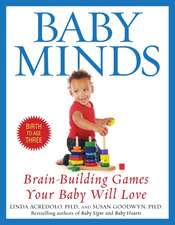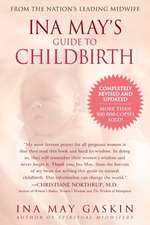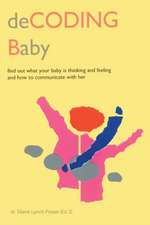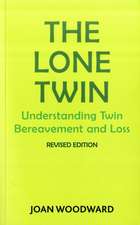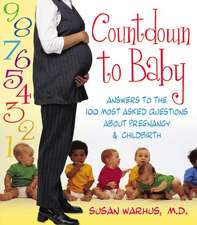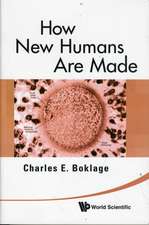Windows to the Womb: Revealing the Conscious Baby from Conception to Birth
Autor David B. Chamberlainen Limba Engleză Paperback – 14 ian 2013
Preț: 113.91 lei
Nou
21.80€ • 22.76$ • 18.04£
Carte disponibilă
Livrare economică 14-28 martie
Livrare express 27 februarie-05 martie pentru 24.74 lei
Specificații
ISBN-10: 1583945512
Pagini: 225
Dimensiuni: 153 x 234 x 16 mm
Greutate: 0.36 kg
Editura: NORTH ATLANTIC BOOKS
Notă biografică
Recenzii
"Splendid, delightfully written, and thorough." —Asley Montagu, anthropologist and author of Touching: The Human Significance of the Skin
Praise for David Chamberlain's previous book The Mind of Your Newborn Baby
"An impressive book which challenges the assumptions we make about babies and impels the reader to look at the newborn child with fresh eyes." —Sheila Kitzinger, author of The Complete Book of Pregnancy and Childbirth
"Alongside of Spock and Brazelton on your parenting bookshelf, make room for a book that sets out to prove babies ... should be recognized for the bright, information-gathering beings they are." —San Francisco Peninsula Parent
"If babies ever stage a protest march, David Chamberlain will be on the front lines." —Sarah Patee, San Diego Tribune
"Put a ribbon around this book for every pregnant woman you know...."—Audrey DeLaMartre, Minneapolis Star Tribune
Extras
Interactive, Social Movement in the Womb
Although traditional psychological theory looked for the beginnings of social behavior long after birth, you may already realize how intimate and relational your life inside mother really is. Can a human being ever be closer than this—woven into her body, your lifelines linked, tucked under her variable heartbeat, memorizing her rising and falling vocal productions? How could you avoid something so close? You live in layered space, not in solitude. Your mother breaks into song! Or tears. Happily or unhappily, she moves through space and you move right along with her. The womb is not an isolation tank.
In the course of growing, you encounter more and more of her richness and rhythm, first the inside sounds, then the blend of sounds outside of her including the recurring sounds of other voices nearby like your father, siblings, or household pets, voices directed toward you. Noises from farther out eventually add to the impersonal cacophony of the world of storms, traffic, sirens, or explosions. Babies don’t ignore these provocations; they get curious and interested, and participate. They are social creatures.
Mothers and fathers are social too: they have their own curiosity and start experimenting with how to communicate with you a few layers down. They may blurt things out spontaneously in their usual adult language, although if they stop to think about it, they tell themselves this is a little crazy because you haven’t yet had time to learn any language. At certain times of day they may sing to you or read stories—something slightly less crazy, but possibly entertaining. Dads think up their own weird experiments. One dad used to announce from time to time in a commanding voice, “This is your father speaking!” With repetition it started to mean something. When he made that statement at birth, the baby immediately turned his head and searched for that voice. They were continuing a relationship established long before birth.
Parents using the prenatal enrichment program created by obstetrician F. Rene Van de Carr like learning how to play the kick game. First they have to notice that you have started to kick somewhere. When that is happening, they touch the abdomen where you are already kicking and say, “Kick, baby, kick!” Babies catch on, and the game progresses as baby kicks in new places being touched. Some parents have even discovered that if they touch in a circle pattern, babies soon learn to kick in a circle! Of course the whole purpose of this is to play together and be social—all within the natural abilities of the baby in the womb.
Van de Carr reports an examination he was doing under ultrasound, as Beethoven’s Fifth Symphony was playing in the background. He observed that the thirty-three-week-old baby was breathing in time with the music. When he stopped the music, the breathing pattern stopped as well. When the music started again, breathing started again, but not in time with the beat. However, after skipping a breath, the baby was again back in cadence with the music.
A colleague of mine, by profession a doctor and by hobby a folksinger, often entertained her baby during pregnancy by singing folk songs. She noticed the baby kicked a lot when she hit the low notes, so she would deliberately invent more low notes. Mother and baby were having a relationship, no doubt of that, but it was not the one she assumed. Clarification came about three years after birth when the baby boy finally had words to explain that he was kicking because he did not like hearing those low notes!
Consider the heretofore “secret” life of twins. With the help of ultrasound, we have learned some of the unforeseen dimensions of their intimate life with each other. In 1996, perinatologist Birgit Arabin and colleagues in the Netherlands discovered just how, when, and where twins first touched each other. By systematically observing twenty-five sets of twins at weekly intervals, they found first touches and reactions at seven weeks from conception. Brief contacts of less than three seconds went to an arm, leg, head, or torso. Initial approaches were slow but became faster with practice. Over the next three weeks touch became longer and more complex between their bodies and extremities. In another week came contacts initiated by sucking movements—all this development in a window of twenty-seven days. Arabin watched as lips met lips and recognized it as a kiss.
Experts around the world who have an opportunity to observe lots of twins report seeing them hitting and kicking each other; some were “boxing,” trading blows back and forth with a pause between. Alessandra Piontelli in Milan has written in painstaking detail about her ultrasound observations of a series of singletons and twins beginning in 1987. Her purpose was to see if there was a continuum of human behavior between the prenatal period and infancy—something she proved with great success in a series of publications. Starting about halfway through gestation, she concentrated on monthly hour-long recording sessions and after birth followed the babies annually for several years. She discovered a hidden world of complex fetal behavior clearly revealing a variety of personalities and relationships previously unknown in psychology.
Twins Marisa and Beatrice hit each other in the womb and continued to do so after birth! Celia and Mark also had a conflicted relationship. Celia was so much in motion that both parents said, “Let’s hope she will calm down after birth.” Her brother, more restless than active, kept turning and folding his legs tightly while screening his face with his hands. He responded to any stimulation coming from his sister by turning away and burying his face deeply inside a distant corner of the placenta. If she persisted in trying to make contact with him using rather gentle motions of her feet and hands, he responded by violently kicking back. She instantly withdrew as if frightened by his strength. At birth, Mark’s mother described his facial expression saying “his forehead is permanently corrugated; somehow he looks permanently tired and old.” At three months of age, when Celia tried to touch him, he always reacted by turning away. At eight months, he was still pushing away his sister’s advances, and mother testified he “often knocked her out!” I cannot think of a more obvious example of the organic relationship between motion and emotion.
Finally, lest you form the impression that all twins are aggressive and angry in utero, Piontelli shares with us the charmed relationship of Luke and Alicia. When first observed at the halfway point in pregnancy, in spite of obvious differences in size and agility, the two were a friendly pair. Luke, agile and active in testing out his leg muscles on the uterine wall¸ would periodically turn his attention to his sister. Reaching out gently with his hands to the dividing membrane that separated them, he touched her face, and when she responded by turning her face toward him, he engaged with her in stroking, cheek-to-cheek motions. From this time, the mother and doctor nicknamed them “the kind twins.”
During the following monthly observations, the kind behavior continued. Alicia was always in a more sleepy and passive role, and Luke, smaller but more active, paused in his exercises to approach his sister by touching her face, after which they engaged in a mutual face-to-face stroking. At one point the mother remarked on how “they seem to cuddle up together.… Look how he strokes her.” After birth this agreeable behavior continued with Luke in the initiative, smiling, seeking interaction with his father and mother, as well as his sister. He seemed interested in everything, including music, the piano, and looking into picture books. He was the first to walk and talk and his parents commented on the “adult quality” of his eye-to-eye contact with them and with his sister.
At one year of age both could walk and were beginning to talk; they showed great delight in playing with each other. Mother reaffirmed that they were still kind to each other and touched each other to express their fondness. She reported that their favorite game had become hiding on opposite sides of a curtain and using it like the dividing membrane in utero. Luke would put forward his hand through the curtain and Alicia reached out with her head and their mutual stroking began, accompanied by gurgles and smiles—just as they did in the womb.
American psychologist Evelyn Thoman studied premature babies who were in the same age bracket as babies still enclosed in the womb, further documenting the social nature of interactions inside and outside the womb, and the organic relationship of motion and emotion as well. Thoman invented a toy teddy bear that could be set to breathe at a rate to match that of each premature baby during quiet sleep. In an experimental format where some babies had a Breathing Bear, some a nonbreathing bear, and some no bear at all, sleeping babies in these three conditions acted very differently. After three weeks the records showed that infants with breathing bears made significantly more contact with their head, body, arms, or legs than the other sleepers. Showing interest in the presence of a breathing “companion,” they moved steadily toward it and interacted with it—I dare say happily. And the experiment showed another significant result. Babies with bears set to breathe at their own rate of quiet sleep ended up spending greater amounts of time in quiet sleep. Were they not intimately engaged with and being influenced by the companion teddy?
In more complex studies with the Breathing Bear as a “rhythmic stimulation” in sleep, babies at thirty-three to thirty-five weeks of conceptional age showed less wakefulness, more quiet sleep, fewer startles in quiet sleep, and less crying. In active sleep (REM), babies with the Breathing Bears were more likely to smile (positive affect) while those with nonbreathing bears were more likely to grimace (negative affect). Researchers concluded that the presence of a breathing bear facilitated neurobehavioral organization. Because premature babies have left the womb early and no longer have close proximity to their mother’s stimulating rhythms, sounds, and movements, there are reasons to think they would appreciate even a small reminder of mother while sleeping in a hospital Isolette.
Finally the story of twins Kyrie and Brielle, born twelve weeks before term, reveals not only the keen social attunement they developed in utero but the grave danger of losing it during a crisis in the premature nursery. In addition they dramatize how eloquent body language can be and how powerfully motion and emotion work in sync. At birth Kyrie weighed two pounds and three ounces, while Brielle weighed just two pounds. In their first month of neonatal intensive care, the gap widened as the larger quickly gained weight and slept calmly. Brielle had breathing problems, heart rate problems, and lower oxygen levels in her blood. She began gasping for breath and her face and stick-thin arms and legs turned bluish-gray. Her parents were terrified she might die.
The nurse tried everything: suctioning the breathing passages and turning up the oxygen flow but the heart rate continued soaring. Desperate she recalled being told that in Europe, multiples (especially pre-matures) were sometimes “double-bedded.” After getting the parents’ permission, she put the sisters together. No sooner had the door of the incubator closed, than the weak one snuggled up to Kyrie and calmed right down. Within minutes her oxygen readings were the best they had been since she was born. As the smaller one dozed, Kyrie wrapped her tiny arm around Brielle. Happily a photo recorded the precious moment, which is how millions of us around the world became aware of this miracle among twins. From that lifesaving moment of reunion, Brielle left the danger zone and started on the road to health.
An excerpt from Windows to the Womb by David Chamberlain, published by North Atlantic Books, copyright © 2013 by David Chamberlain. Reprinted by permission of publisher.
Descriere
Windows to the Womb is an eloquent guide through the first nine months of life from conception to birth. In the past, the invisible physical processes of fetal development were mysterious and largely unexplainable, but in the past half-century, breakthroughs in embryology, interuterine photography, ultrasound, and other sensitive instruments of measurement have enabled us to make systematic observations inside the womb. We now understand that fetuses are fully sentient and aware beings. In this new climate of appreciation for the surprising dimensions of fetal behavior, sensitivity, and intelligence, this book brings a host of new information to light about the transformative journey each one of us must undergo in the womb.
With reverent awe, the author describes the amazing construction of our physical bodies, the "ultimate architecture," and draws parallels with the expansion of our minds as our brains and senses develop and grow. Dr. Chamberlain details new discoveries in embryonic and fetal research that support his own findings on the impact of the mother's emotional and physical state during pregnancy; the importance of bonding at the earliest stages, long before birth; and the steps that expectant parents can take to ensure the most nurturing start in life for their children.





